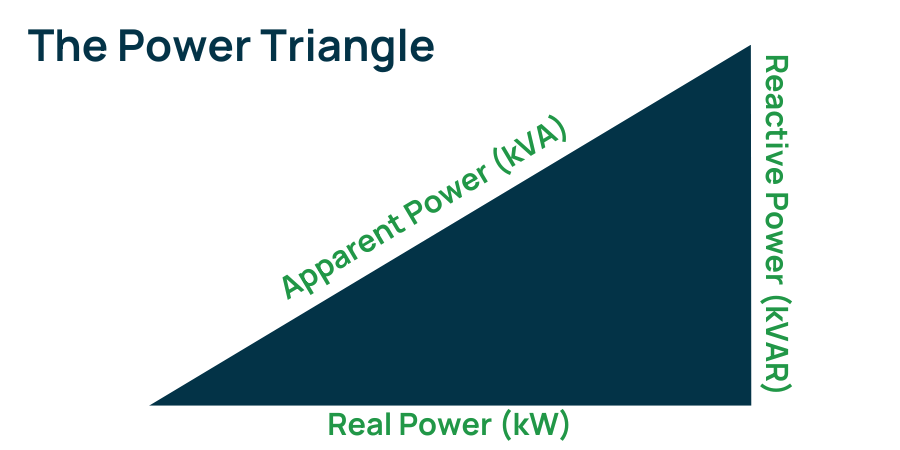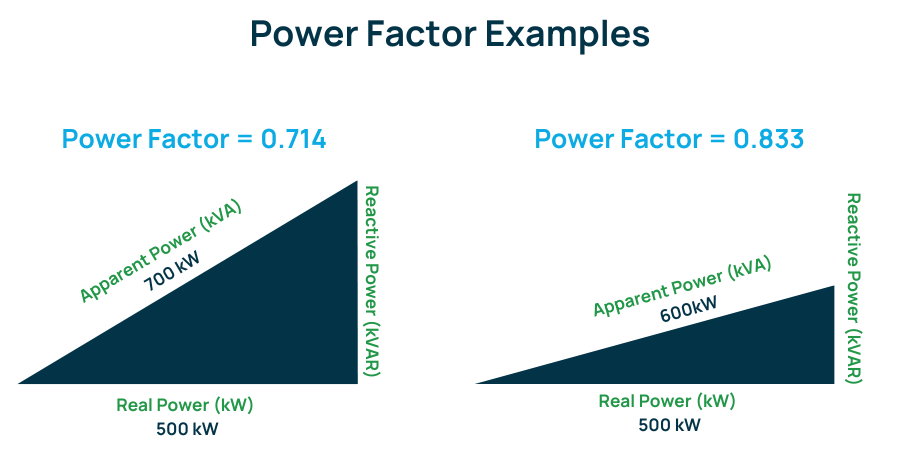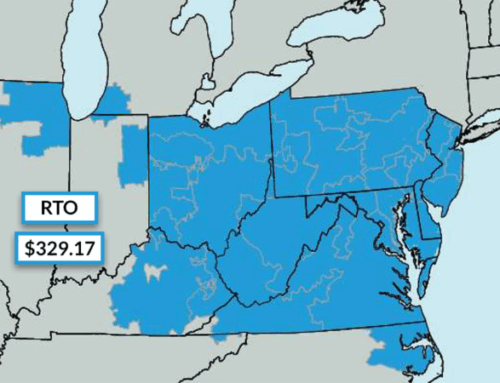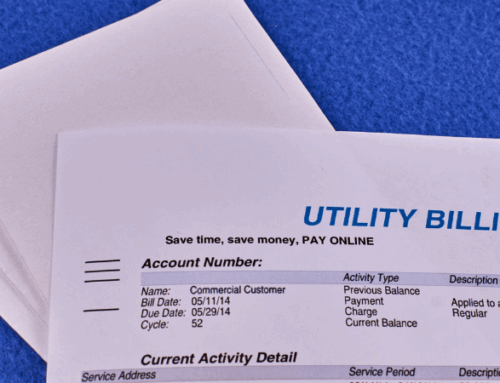In the world of energy management, power factor is a critical concept that directly impacts energy efficiency and costs. For businesses looking to optimize their energy usage and reduce energy costs, understanding power factor and implementing power factor correction can lead to significant savings. This article will explore what power factor is, how it’s calculated, and why correcting it is essential for both reducing energy bills and improving overall system efficiency. We’ll also give you some tips for correcting your power factor rating.
What Is Power Factor?
Power factor is a measure of how effectively electrical power is converted into useful energy in a building or application. In simpler terms, power factor indicates how efficiently the electricity being supplied is used. Power factor is expressed in a number 0 to 1, with 1 being the most efficient and 0 being the least. While this number represents the efficiency of a building, it does not have a direct impact on electricity bills for all businesses. Some utility company tariffs, however, charge businesses with low power factor ratings, so finding ways to improve efficiency is a top priority for these organizations. Let’s explore more about how power factor is calculated.
How Is Power Factor Calculated? The Power Triangle
PF is a ratio ranging between 0 and 1. A power factor of 1 (also known as “unity”) means that all the electrical power is being used effectively, while a lower power factor indicates inefficiency, where more power is being consumed without performing additional work.
A good power factor is close to 1, indicating efficient use of electricity. A bad power factor, typically below 0.9, means that the electrical system is using more power than necessary, leading to higher energy consumption and increased costs. Poor power factor can also result in additional charges on your energy bills due to the extra strain it places on the electrical distribution system.
To calculate power factor ratings, engineers use something called the Power Triangle.
The Power Triangle is a fundamental concept in electrical engineering that helps visualize the relationship between three types of power in an AC (alternating current) electrical system:
- Real Power (kW)
- Apparent Power (kVA)
- Reactive Power (kVAR)
These three elements form the sides of a right triangle, where understanding each component is crucial for managing energy efficiency.

Real Power (kW)
Real Power, measured in kilowatts (kW), is the actual power that is used to perform work in an electrical system. This is the energy that powers your lights, runs your machinery, and operates all electrical devices. Real Power is what you want most of the electricity you consume to be converted into because it directly translates into useful work. In simpler terms, it’s the power that does the “real” job of running your equipment.
Apparent Power (kVA)
Apparent Power, measured in kilovolt-amperes (kVA), is the combination of Real Power and Reactive Power in a system. It represents the total power supplied by the utility company to power both the productive and non-productive parts of your electrical load. While Real Power is what you use to perform actual work, Apparent Power is the total amount of power drawn from the grid. Think of it as the “total” power your system draws to keep everything running, including the waste.
The key relationship here is that Apparent Power is always greater than or equal to Real Power because it also includes Reactive Power.
Reactive Power (kVAR)
Reactive Power, measured in kilovolt-amperes reactive (kVAR), is the power that doesn’t do any useful work but is necessary for maintaining the voltage levels in your electrical system. It’s needed to create the magnetic fields required by inductive loads like motors and transformers to operate correctly. However, Reactive Power doesn’t contribute to the actual energy consumption that turns into work—it’s more like a supporting player that keeps everything running smoothly.
If you imagine the electricity in your system as water in a pipe, Real Power is the water flowing forward doing useful work, while Reactive Power is the water swirling around the sides of the pipe, not contributing to forward motion but necessary to keep the water flowing properly.
Power Factor: The Efficiency Ratio
The Power Factor is the ratio of Real Power (kW) to Apparent Power (kVA). It’s a measure of how effectively the electrical power is being used in your system. The formula is:
Power Factor = Real Power (kW) / Apparent Power (kVA)
In practical terms, the lower the Power Factor, the more Apparent Power your system needs to draw to perform the same amount of work. This inefficiency can lead to higher energy costs and unnecessary strain on the electrical infrastructure.
The Power Triangle Visualization
Visualizing the Power Triangle helps make sense of these concepts. In this triangle:
- The horizontal side represents Real Power (kW), the power doing actual work.
- The vertical side represents Reactive Power (kVAR), the power that supports the system but doesn’t do useful work.
- The hypotenuse (longest side) represents Apparent Power (kVA), the total power required to run the system.
The angle between the Real Power and Apparent Power sides of the triangle represents the phase difference between current and voltage. The smaller this angle, the closer the Power Factor is to 1, indicating a more efficient system.

What Is Power Factor Correction?
Power factor correction involves improving the power factor of an electrical system, bringing it closer to 1. This is typically achieved by adding capacitors to the circuit, which help to offset the effects of inductive loads. Inherently, inductive loads are lagging, meaning the current lags the voltage, creating reactive power. This creates an imbalance in the system and lowers power factor. Correcting the power factor makes the system more efficient, reducing the amount of reactive power required and thus lowering the overall energy consumption.
Power factor correction works by reducing the amount of reactive power in the system. Since reactive power does not perform any useful work but still requires energy to be generated and transmitted, reducing it leads to a decrease in the total apparent power. This, in turn, reduces the overall demand on the power system, leading to lower energy consumption and less strain on the electrical infrastructure.
Ways To Improve Power Factor
Improving power factor can be achieved through several methods, each suited to different types of electrical loads and system requirements:
Capacitor Banks
Installing capacitor banks is one of the most common methods of power factor correction. These capacitors provide reactive power to the system, reducing the need for reactive power from the grid and thereby improving the power factor.
Synchronous Condensers
These are specially designed synchronous motors that can adjust their power factor by adjusting in real time. They are typically used in larger industrial applications where precise control of power factor is required.
Active Power Factor Correction
APFC systems use electronic components to continuously monitor and adjust the power factor of the system. This method is highly effective for systems with fluctuating loads, where traditional methods like capacitors might not be sufficient.
Harmonic Filters
In systems with significant harmonic distortion, harmonic filters can be used to improve power factor by reducing the harmonic content in the electrical system. Harmonic distortion happens in non-linear loads where voltage and current are not proportional to each other.
Benefits Of Power Factor Correction
Correcting your power factor can lead to substantial savings on your energy bills. Not only will you reduce your overall energy consumption, but you will also avoid power factor penalties and additional charges that come with a low power factor. For businesses, this can mean significant cost reductions, especially in industries with high energy demands.
Reduction In Energy Bills
By improving your power factor, you can reduce the amount of electricity your system needs to draw from the grid. This reduction in energy consumption translates directly into lower energy bills. Additionally, many utility tariffs impose penalties for low power factor, so improving it can also eliminate these extra charges.
Enhanced Energy Efficiency
A higher power factor means your electrical system is operating more efficiently. This not only reduces your energy costs but also decreases the environmental impact of your operations by lowering your overall energy consumption.
Increased Capacity Of Your Electrical System
With power factor correction, your electrical system can handle more load without the need for additional infrastructure. This is because less current is required to deliver the same amount of power, freeing up capacity in your system.
Reduction In Reactive Power Charges
Some energy tariffs include charges based on the amount of reactive power used. By implementing power factor correction, you can minimize or even eliminate these charges, leading to further savings.
Want To Improve Your Power Factor Rating?
Power factor correction is a crucial aspect of energy management that can lead to significant savings. By understanding and correcting power factor, organizations can reduce their business energy consumption, avoid power factor penalties, and increase efficiency. For more information on how to optimize your energy usage and reduce costs, contact our team of energy experts today.



